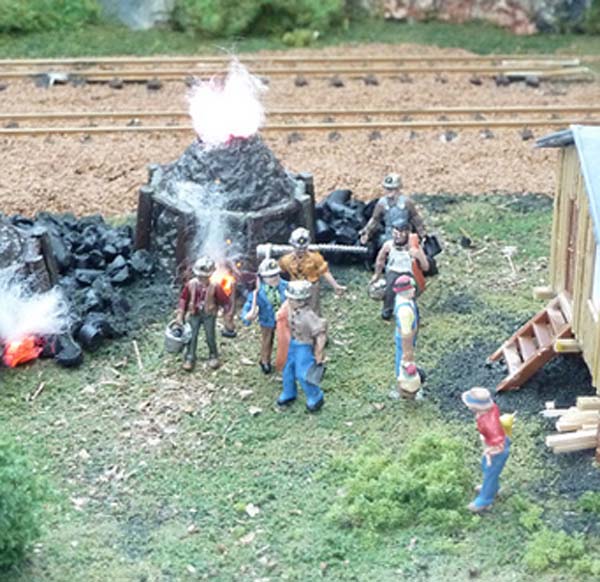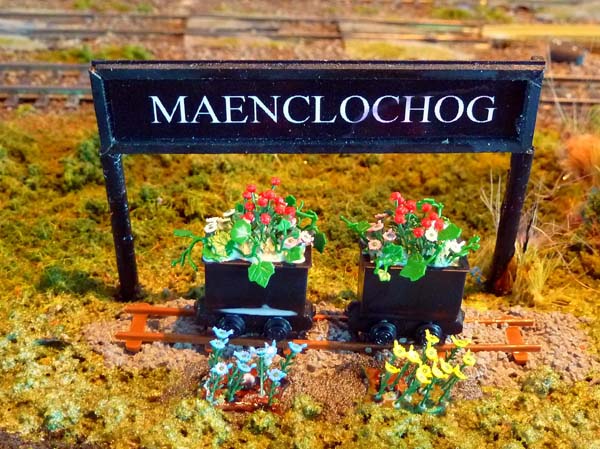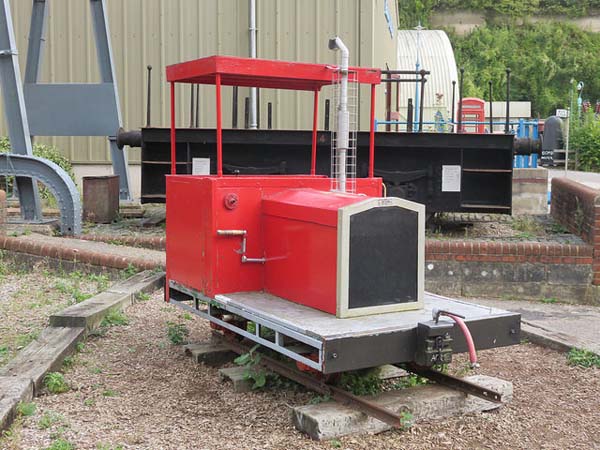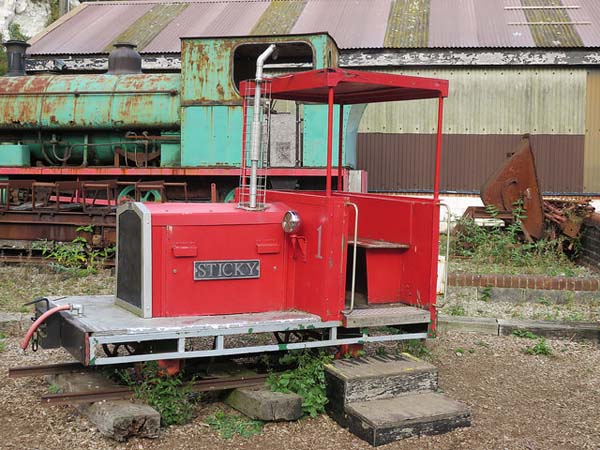Treacle Mines
With apologies to Terry PratchettIntroduction
Growing up in Orpington my parents had a problem trying to get me to go to bed. They frequently promised me a visit to the Cudham Treacle Pits if I would be good. This bribe worked every time although I never managed to visit this fabled location. Aunts and Uncles also spoke about the Cudham Treacle deposits. In later life I have found that others, roughly my age, were also bribed into going to bed with a promise of a visit to the local treacle mines. Reading Terry Pratchett brought a sort of reality to those early dreams. My railway model modules also echo my thoughts on treacle mining.
Naturally Occurring Treacle
“In the same way that ancient forests became coal, ancient swathes of natural sugar cane can become, under the pressure of millennia, what in various parts of the (world) is known as hokey-pokey, pig treacle, or rock molasses. But much boiling and purification was necessary to create the thick golden syrup that was the city-dweller’s honey.” [1]
The creation of theriaciferous or treacle-bearing rock came about through the fortuitous collision of a meteor on to thousands of acres of prehistoric sugar cane resulting in dense crystalline sugar which was the foundation of a large mining, confectionary and dentistry industry. [2]
In "Raising Steam" Terry Pratchett recounts the dwarfish legend of the Nougat Knights who at the beginning of the world, created the treacle mines and other subterranean sweets. Of course, there is no truth in this mythology.Treacle Refining
In earlier times the refining was a simple affair with the pig treacle being heated in a beehive kiln similar to a charcoal burner. The ore was left for several days until it flowed out of a channel at the bottom where it was collected into barrels.

The treacle burner at Clynderwen with the miners returning from a hard days work in the Rosebush mine.
The beehive kilns are now a thing of the past. Treacle-bearing matter is detected nowadays by its fluorescence under ultraviolet illumination. In modern treacle refineries the ore is crushed, ground and extracted with various organic solvents, then concentrated by vacuum distillation. An additional distillation is required to remove the rat urine where the treacle army had been at work. The resulting heavy liquor is layered into wooden vats, sealed and left to mature for up to 10 years. It is at this stage that the distinctive flavour of treacle emerges. After maturation, batches are usually blended to give added smoothness of taste.
Other uses for treacle
Paving Stones
Slabs of unrefined hard treacle were tried as paving stones. [2] However, this did not work too well in hot humid weather when the treacle would soften and people standing still would find themselves glued to the spot. There are several stories of dogs standing on the side walk with their legs stuck fast having to lick their way out of a serious predicament.
Roofing Slates
It is recorded that slabs of hard treacle were successfully used as roofing slates. The action of the sun would, over time, cause a flow of treacle towards the lower part of the roof but this was easily remedied by turning each slate upside down so that the thick part was now uppermost. In this way, it was claimed that the roof would last indefinitely.
Mollusc Card
With the opening of the Ankh-Morpork and Sto Plains Hygienic Railway [9] there came a new use for pig treacle along with sapient pear wood. Sapient pear wood had long been used for wizards staffs and luggage where it was prized for never being separated from its owner. The opening of the railway into Lancre opened up additional supplies of this intelligent wood which had previously been thought practically extinct. This quality was useful in several ways, particularly for fireman’s coal shovels where it was impossible for a fireman to accidentally lose his shovel in the fire.
Normal railway tickets were written out laboriously by hand on vellum. In busy times an army of clerks was necessary to keep up with the demand. The advent of printed tickets, together with a shortage of vellum helped somewhat but a huge stock of tickets was required to cover the different journey possibilities. For frequent or repeat travellers the Mollusc card [10] was invented. A piece of sapient pear wood was impressed as a ticket upon the traveller. This included a small box into which a measured amount of treacle was deposited according to the needs of the owner who paid up front and could add treacle as required.
Upon entering the train the traveller would place his ticket against a small box, known as a fareograph, close to the door. This was a development of the iconograph containing an imp who had access to a fare chart, timetable, manifest and calendar, all in miniature. The imp communicated with the pear wood and took off the appropriate amount of treacle from the ticket. Once the fare was paid the imp would scurry back into the box and hit a bell with a small hammer to indicate a successful transaction. If the fare required exceeded the amount of treacle available, or the card was not properly impressed sapient pear wood, the imp would jump out and start to pound the traveller around the face with his tiny fists.
This created opportunities for unscrupulous itinerant sellers on platforms attempting to sell watered down treacle to the unwary. Some even tried to pass off Fratchwood timber from the enchanted forest of Skund as sapient pear wood. These scams were easily picked up by the ever vigilent imps. However, C.M.O.T. (Cut me own throat) Dibbler managed to obtain a license from the railway to sell top up treacle from his tray along with his sausages of dubious provenance. "By official appointment to the railway. Get your top up treacle and sos' ina bun 'ere."
The advantage of this system was that because the ticket was permanently bonded to the traveller there was no possibility of fraud or theft. At the beginning of the run the conductor was required to inspect each fareograph and place a knob of butter inside – imps love butter. At the end of the run the conductor would collect the treacle and turn it in with his cash and cancelled tickets.
OC Transpo investigated the possibility of using the fareograph system on its buses but were unable to find suitable supplies of sapient pear wood or treacle and so the Presto card was used instead.
Traditions and Customs
The ancient Britons used woad as a blue body paint and to tattoo themselves, therefore the Romans called them, “painted people”, or Picts. In treacle bearing areas the blue designs were supplemented by using treacle to produce orange highlights. Treacle was also mixed with the woad to produce a more permanent finish. Over time, young men and women would paint treacle over various parts of their bodies to indicate they were available. Local chieftains also daubed treacle to indicate places on their bodies where men paying tribute or swearing allegiance should kiss. This was the origin of the well-known phrase, “Kiss my a---“. It was a tough job being a chieftain in those times. They had to stand up throughout the entire ceremony – if they sat down they never knew if they would be able to get up again.
Maenclochog-Rosebush Treacle Mines

Display of treacle mine cars at Maenclochog station
Maenclochog Treacle Mining
Two outcrops of theriaciferous rock can be found at Maenclochog and close by at Rosebush. Maenclochog Treacle and Rosebush Treacle have to be tasted to appreciate the difference. Connoisseurs prefer Single Mine Treacle in which the different characteristics of the mine can be savoured. Maenclochog Treacle was prized for its underlying axle grease taste with long finish of cordite while Rosebush treacle had a happy aftertaste of WD 40.
But there were problems to be overcome. As the mine became deeper and deeper the highly concentrated treacle fumes gathered in the roof and threatened to engulf the miners. They tried a canary which had been used successfully in coal mines to warn of the presence of gas but it just sat in its cage all day happily pecking at a piece of pig treacle and grinning to itself. One day someone proposed the perfect solution.
“Everyone knoweth that femalef are fusceptible to sugar highs, especially younger ones. If we putte a virgine on a tuffet [3] and hauled it up unto the roofe, we would knoweth, by her actionf, when the fumes would becometh dangerous.”
This worked for a short while but the virgin would emerge at the end of the shift completely covered in thick treacle. Running to the entrance she would be chased by the miners anxious to remove the treacle which covered her entire body. These were the original treacle tarts. It became a rule that the day’s haul of treacle would be carried out by the man who had cleaned off the previous virgin. This was thought to be a suitable handicap to give the others a chance.
This gave rise to the nursery rhyme:
Little
Miss Muffet sat on a tuffet,
Eating her curds and whey,
Along came a miner,
Who sat down beside her
And licked all the treacle away. [4]
However, the use of virgins was frowned upon by the wives and, in any case, the village quickly ran out of virgins. The pending crisis was averted by a suggestion that the virgin be replaced by a nagging witch. The hapless woman was placed in a cage close to the roof and the miners knew that when the nagging started it was time to leave. Frequently they forgot to let the nagger down.
The ventilation problem was finally resolved by the installation of a steam powered beam engine which pumped air into the workings. The air found its way out of the mine through crevices in the rocks and occasionally a high pressure vent would be found by children who would hold a stick across the outflow and quickly make cotton candy.
A recent treatise gives an indication of the way in which the mine was worked:
“It was part of the winding gear from one of the original treacle mines, long since abandoned. One of the lifting buckets was still up there, glued to the floor by its last load of heavy, sticky, unrefined treacle, which, once set, was tougher than cement and more waterproof than tar. (Commander) Vimes remembered as a kid, begging chippings of pig treacle off the miners; one lump of that, oozing the sweetness of prehistoric sugar cane, could keep a boy’s mouth happily shut for a week” [1]
In an effort to open up new supplies several ventured out into the hills above Rosebush prospecting for treacle. Coming to a likely spot, one of the prospectors thrust a pointed stick into the ground and hit a gusher. It took three days to control the flow by which time the surrounding countryside was covered in treacle. Anxious to ascertain the extent of the find, he investigated further and found a small spring under which liquid treacle had been fermented into rum. Unable to believe his luck at coming across a supply of rum which had been aged for over a million years, he sampled the rum rather too freely. Five days later he staggered back into town with an enormous hang-over and claiming that he would be rich beyond his wildest dreams. Unfortunately, in taking five days to find his way home, the location of the rum was forgotten and nobody has since been able to find it.
In later years, the legend of the prehistoric rum cache was used in the marketing of local candies under the Jurassic trade name. Jurassic hard rum treacle toffee and gobstoppers were very popular in the area but their sale was eventually banned, much to the chagrin of dentists everywhere, by the Department of Health on the grounds that these caused serious dental problems
There have been accidents in the mine, several serious ones. In 1771 a treacle face collapsed under the pressure of liquid syrup. The flow could not be stopped and the section had to be sealed off, leaving behind two comrades who had drowned in the flow. Many years later this section was reopened and the two miners were found completely crystallized from the inside out. The day they removed the first corpse there was a downpour and before they knew it the body had completely dissolved in the rain. The second body was successfully retrieved and a wake was held on a day that was ever after known as “Sweet Tuesday”. There was an open casket. When it came time for the interment there was little left as the mourners had nibbled off the sugary bits to console themselves.
The Rosebush Railway built a tunnel along part of its route and the workings passed through the theriaciferous seam. One day, in 1874, the tunnel was inspected by a group of local railway barons and pillars of the community. The roof caved in and they were engulfed in treacle. When the section was reopened it was found they had all been crystallized where they stood. Thus pillars of the community had been turned into roof supports.
There is an ancient tradition that says it is bad luck for anyone leaving the treacle mine to turn round and look back. The origins of this folk lore are unclear. It may be a biblical reference to Lot’s wife who was turned into a pillar of salt when she looked back. It may be that men leaving the mine at a time of danger wanted to ensure that a nagging witch was indeed left behind. The most reasonable explanation is that a miner chasing a treacle-covered virgin would stand less chance of catching her if he looked back.
There is a song entitled "Much Binding in the Treacle Mines" written back in the 50s that encapsulated much of the history of the mine. The words of this ditty are less well known than the second version of the song (the Marsh version) and are difficult if not impossible to find.
Treacle Miners at War
During the two world wars the Treacle Miners performed a patriotic role. They were trained to hide in the mine and, in the event of an invasion, come out to hamper the enemy. This was not required because there never was an invasion. However, a renegade group came out in July 1947 and started to take Maenclochog apart. They were disappointed when it was explained to them that the war was over and that we had won so they continued in their path of destruction. They were taken into custody and forced to emigrate to Canada where they make their presence felt at G8 summits and whenever Vancouver or Montreal lose a Stanley Cup Final game.
During the second world war the then unused Rosebush tunnel was used as a training exercise designed to test the new ‘Highball’ bouncing Bombs designed by Barnes Wallis. Two bombs went straight through the tunnel, with seven hitting the tunnel portals. [5] This activity caused the treacle seams to leak thus providing a good local source of nourishment at a time when foodstuffs were very difficult to obtain.
Maenclochog Treacle Water Spa
These waters were particularly valued by women as they both enriched the skin as well providing a healthy glow. Wealthy silk merchants also valued the product at night as it minimized the unfortunate, and at times embarrassment, of sliding out of bed due to the coefficient of friction of said bed linen.
In discussing the Maenclochog treacle water spa it should be noted that the ladies had two options when they were ready to leave the waters. They could either use a towel or engage the Maenclochog equivalent of a pool boy. After generations of plying their trade in the mines, the miners developed particularly large tongues, the use of which was much sought after by the more fashionable ladies.
The spa company fell behind in their payments to the Great Western Railway to the point where the railway initiated an action which forced the spa company into bankruptcy. The GWR thus acquired the spa assets and reopened it using a new herald for the operation.

Maenclochog Treacle Today
The Maenclochog Treacle Mine was closed down for safety reasons. A safety inspector from the Ministry of Mines and Unnatural Resources made a visit one day. He found miners working in a gallery around an open pit with an unprotected 50 foot drop. The mine owners agreed to have their men working with safety harnesses. The inspector made a follow-up visit and found that the miners were working with safety harnesses 75 feet long to give them room to move around.
The Maenclochog treacle water became very popular. It is now moved in railway tank cars to urban centres where it is bottled and sold to discerning, or gullible, customers.
All that is left of the original treacle mine is the small display of mine cars filled with flowers at the Maenclochog Station. This was placed there by the National Union of Treacleminers (NUTS) in memory of the men and women who lost their lives, or their virginity, in the treacle mine.
In the summer of 2011 a narrow gauge railway was laid in under the cliff by the Great Western Railway locomotive yard and into the old treacle mine. A small, narrow gauge locomotive was imported from the Zillertalbahn in Austria in preparation for the opening of a tourist ride into the mine.

The Zillertalbahn tourist train
The Cudham Treacle Pits
Cudham is a small village in West Kent, near Pratts Bottom [6] and close to Orpington. At Cudham the Treacle Pits were in the form of an opencast strip mine rather than a deep mine. The Cudham Treacle Pits were first developed by the Amazing Maurice and his educated rodents. This cat created an army of rats, known as the Treacle Army (TA) and ran it under military principles and discipline. There were four platoons.
 the West Kent Corps of Engineers
were the
pathfinders. They went in first to scout out the most
promising seams and
ensure that the area was safe from falls of pig treacle and syrup
gushers.
the West Kent Corps of Engineers
were the
pathfinders. They went in first to scout out the most
promising seams and
ensure that the area was safe from falls of pig treacle and syrup
gushers.
 the West
Kent Corps of Widdlers came next. It was
their task to loosen up the seams and make the extraction easier.
the West
Kent Corps of Widdlers came next. It was
their task to loosen up the seams and make the extraction easier.
 the
West Kent Infantry did the heavy work using axes
stolen from unwary dwarfs. This was particularly difficult
and onerous
work bearing in mind that rodents do not have opposable fingers.
the
West Kent Infantry did the heavy work using axes
stolen from unwary dwarfs. This was particularly difficult
and onerous
work bearing in mind that rodents do not have opposable fingers.
 the
West Kent Corps of Heavy Widdlers were a specially
trained group with extra large bladders kept in reserve to act as a
flying squad
to tackle particularly difficult seams.
the
West Kent Corps of Heavy Widdlers were a specially
trained group with extra large bladders kept in reserve to act as a
flying squad
to tackle particularly difficult seams.
This system worked well provided there was a good supply of fresh water to resupply the widdlers. It was the supply of water which caused the downfall of the Cudham Treacle Pits. As the workings progressed the widdlers had to go further and further to take in fresh supplies of water. The Corps of Engineers tried to bring the water to the rock face by diverting a stream into the workings. Unfortunately a downpour created a flash flood which inundated the workings with a significant loss of rodent life and the project was abandoned.
However, Maurice soon found a good use for his organizing skills. He reformed the rodents into a maurauding army which terrorized villages as recounted in Terry Pratchett's book "The Amazing Maurice and his Educated Rodents" [7]
Sompting Treacle Mine
An undisclosed source at the Home Office Archives, who prefers to remain anonymous, reports that there was always speculation that Sompting Treacle Mines was a front cover for a predecessor agency to what Mr. Conan Doyle discreetly referred to as the "Home Office". Certainly, reference was made in the (since sealed) archives of the UK Customs Service of officers of the Sompting Treacle Mine Company being agents of the Political Intelligence Executive (PIE) since the early days of the service (relieving smugglers of their best Cognac for the Monarch) and more recently during the Napoleonic Wars and build up to the first great war.
It is also worth noting that since 1961, there has been no map reference on the Ordnance Survey of Sompting Mines (similar to Porton Down, the Hereford Barracks, Wayfarer House or the cousins famed area 51). Early London Brighton and South Coast Railway maps and timetables show an occasional service to the Sompting Spur from Worthing; yet by 1923 and the birth of Southern Railways, the spur had again disappeared from all maps and schedules.
Since 1921 it has been assumed the PIE was integrated into what TV shows have popularised as MI5 (the Domestic Service). Although little is known about the business of treacle, by 1989 Mrs Thatchers great objective to privatise the funding and delivery of "intelligence" services could have resulted in grant funding for the company ceasing, thereby contributing to their collapse.
There is a positive survivor from the Sompting Treacle Mine in the form of a locomotive which used to work on the Sompting Mine railway. Called “Sticky”, it is now safely stored in the Amberley narrow Gauge Railway Museum. A plaque explains its history.
ACME RAILCAR COMPANY
8HP
4 cylinder petrol engine with parented
"Autodrive" drive system.
Built in the Company's Lion Works in Coventry in 1941 to
the order of the
Ministry of Fuel and Power, for use in forestry work in
North Wales
to an unusual gauge of 2ft 1ins.
Sold off in 1952 to a local company Cokeham Porridge
Quarries Ltd,
it was later transferred to Sompting Treacle Mines
Ltd,
where it was used in No. 2 Mine until a slump in world
treacle prices
caused the company to cease trading in 1989.
It was there that it was discovered in a derelict
condition and was brought to the Museum and restored for the training
of junior
engine drivers.


Pictures of Sticky taken in September 2014.
Treacle Mines - an Appendix [8]
Embedded in place-names, lurking like hidden diamonds, are precious traces of past history and traditions. There is, for example a street in Ankh-Morpork called Treacle Mine Road, running from Misbegot Bridge to Easy street. It takes its name from the treacle mines which used to be worked in this area, which are ancient, very ancient indeed. The deepest levels contain the remnants of pig-treacle measures that are estimated to be 500,000 years old, intermingled with basalt slabs carved with archaic trollish pictograms. The mines were abandoned many years ago, and most people believe that this was because they were exhausted. However, when some deep-down dwarfs (grags) bought property on that street and began mining below it, for reasons of their own (as told in Thud!), they reopened old tunnels and galleries, and their bores struck some residue of deep treacle.
Up in the mountains, on the borders of Uberwald, there are still very, productive treacle mines, enabling the dwarfs of that region to make a handsome profit exporting both raw pig-treacle and luscious treacle-based confectionery to the cities of the plain. Far away in the hot and Swampy realm of Genua, there are lakes of liquid treacle fermenting happily only a little way underground' and occasionally bursting out under pressure to create springs of rum. Near Quirm there are toffee beds. The origin of all this succulence goes back to the Dawn of Time, when the Fifth Elephant collided with the Disc with so great an impact that thousands of acres of prehistoric wild sugar cane was buried under massive landslides and compacted into a dense crystalline mass.
Those who study the effects of cosmic resonance in the space-time continuum of the multiverse often cite the Treacle Mine Phenomenon with amazement and awe, for it has been shown without doubt that these mines, which are a plain fact of geography on the Disc, have insinuated them selves into the folklore of a world where they do not actually exist, and never have done. In England, there are at least thirty villages reputed to have a secret treacle mine tucked away somewhere on their territory. Even more astonishing, there is one place, the village of Patcham in East Sussex, where people have a fairly accurate idea of how the treacle was formed (allowing for the fact that this world sadly lacks any cosmic elephants). A Mrs. Austen told the West Sussex Gazette in 1973 the tale she knew, and had passed on to her children:
Millions of years ago, when England was a tropical country, before the Ice Age, sugar cane grew here. Year after year it grew, ripened and rotted unharvested. The molasses draining away down into the folds of the hills, where it accumulated above an impermeable layer of clay. The centuries passed, the colder weather came, and sugar cane no longer grew on the Downs, but the underground layer of treacle lay patiently waiting until in 1871 Peter Jones, a scientist who had long suspected its existence, sank the first shaft. The ensuing treacle gusher, spouted for three days, covering the countryside for several miles around with a fine rain of treacle, until it was at last brought under control.
Elsewhere, other explanations are offered. At Chobham in Surrey, military incompetence is alleged to be the cause. It is said that soldiers who encamped on Chobham Common before setting out to the Crimean war (others say, American troops stationed nearby during the First World War) buried vast stockpiles of supplies, including drums of treacle and molasses, and forgot to remove them when they left. The drums corroded, and a subterranean reservoir of treacle was formed.
Other places do not attempt to account for the origin of the precious substance, but tell ingenious tales about its discovery and use. The mine at Jarvis Brook near Crowborough (Sussex) was supposedly begun by the Romans, who carved the solid treacle rock into jewellery, but never found out how sweet it was; this was discovered accidentally when a medieval baby prince was visibly soothed by sucking his mother's necklace. At Sabden (Lancashire) it is claimed that boggarts (a species of goblin) are employed in the mine to lick up any spilt treacle; cards and souvenirs about the mine are sold to tourists.
Yet, sad to say, the people, who tell these tales do not take them seriously. It is all a poker-faced joke, a hoax, a leg-pull, used by the locals to hoax gullible outsiders, by parents to entertain their children, by older children to make fools of young ones. While all the time did they but know it, the remains of a real treacle mine lie below the streets of Ankh Morpork.
References
Wikipedia http://en.wikipedia.org/wiki/Treacle_miningThe Treacle Mines of England https://britishfoodhistory.wordpress.com/2012/04/01/the-treacle-mines-of-england/
All Things Treacle http://www.treacleminer.com/
Treacle Miner Jimmy Smuggles http://www.geoverse.co.uk/2013/11/19/jimmy-smuggles/
The Treacle Miner's Tale as recounted in "Raising Steam" p41.
Footnotes
1 Pratchett, T. “Night Watch”2 Pratchett, T. “The Fifth Elephant”
3 A tuffett is a term for a piece of furniture used as a footstool or low seat.
4 Anon
5 http://www.experiencepembrokeshire.com/home-2-2-2-2/hiddenheritage/military/maenclochog/maenclochog-railway-tunnel/
6 Yes, there really is a village called Pratts Bottom near Orpington.
7 http://en.wikipedia.org/wiki/The_Amazing_Maurice_and_his_Educated_Rodents
8 Pratchett, T. and Simpson, J. “The Folklore of Discworld”, 2008
9 Pratchett, T. "Raising Steam", 2013.
10. The Mollusc card was introduced by Moist von Lipwig as described in T. Pratchett "Mrs. Bradshaw's Handbook.